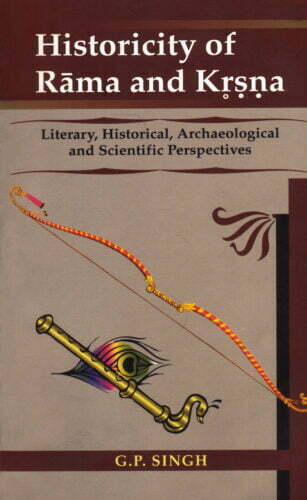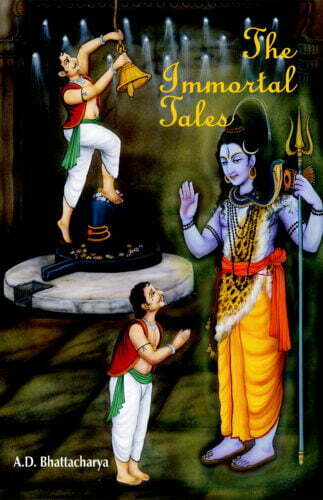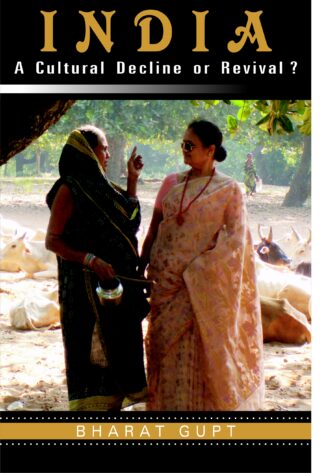Showing 111–120 of 384 results

This monograph is a research-based disquisition on the historicity of Rama and Krishna. Their historicity has been proved on the combined testimony of literature, history, archaeology and science. The work is largely based on original sources, deals with all relevant aspects of the subject and provides new insights into the history of India of the epic age.
This monograph is a research-based disquisition on the historicity of Rama and Krishna. Their historicity has been proved on the combined testimony of literature, history, archaeology and science. The work is largely based on original sources. It deals with all relevant aspects of the subject. It provides new insights into the history of India of the epic age. The author has brought to light many new facts relating to the subject. They will enlighten the inquisitive readers.The work is of immense value not only for the historians and archaeologists but also for those who are genuinely interested to know truth about the subject.

A comprehensive work on chaste Sanskrit inscriptions of ancient Tamil Nadu, under Pallavas, Pandavas, Coëas and their vassals; focussing on the then prevalent socio-economic, literary, religio-cultural and administrative paradigms. A valuable contribution to the field of epigraphy and history of Tamil Nadu.
Inscriptions are the most authentic and vital source for reconstructing the history of India. Epigraphs were composed in Sanskrit in various parts of India and the ancient Tamil country was no exception to this practice. Among the thousands of epigraphs found all over Tamil Nadu, a large number are composed in chaste Sanskrit and these as well as the Sanskrit portions of the bi-lingual copper-plate records serve as an important source of data about the conditions which existed in the ancient Tamil country. These Sanskrit inscriptions are also excellent pieces of prose and poetry and reveal the high standard which this language had attained in the ancient past in the Tamil country. This is a comprehensive and interesting work dealing with the Sanskrit inscriptions of ancient Tamil Nadu belonging to the period of the Pallavas, Pandyas and Colas and their vassals. It focuses attention on aspects of civil and military administration, social and economic life, education, literature and also the religious and cultural conditions of those ages. These inscriptions serve to highlight the cultural richness which Tamil Nadu enjoyed specially under the Pallavas, Pandyas and Colas. This book is a valuable contribution to the field of epigraphy and to the history of Tamil Nadu.

A comprehensive work on chaste Sanskrit inscriptions of ancient Tamil Nadu, under Pallavas, Pandavas, Coëas and their vassals; focussing on the then prevalent socio-economic, literary, religio-cultural and administrative paradigms. A valuable contribution to the field of epigraphy and history of Tamil Nadu.
Inscriptions are the most authentic and vital source for reconstructing the history of India. Epigraphs were composed in Sanskrit in various parts of India and the ancient Tamil country was no exception to this practice. Among the thousands of epigraphs found all over Tamil Nadu, a large number are composed in chaste Sanskrit and these as well as the Sanskrit portions of the bi-lingual copper-plate records serve as an important source of data about the conditions which existed in the ancient Tamil country. These Sanskrit inscriptions are also excellent pieces of prose and poetry and reveal the high standard which this language had attained in the ancient past in the Tamil country. This is a comprehensive and interesting work dealing with the Sanskrit inscriptions of ancient Tamil Nadu belonging to the period of the Pallavas, Pandyas and Colas and their vassals. It focuses attention on aspects of civil and military administration, social and economic life, education, literature and also the religious and cultural conditions of those ages. These inscriptions serve to highlight the cultural richness which Tamil Nadu enjoyed specially under the Pallavas, Pandyas and Colas. This book is a valuable contribution to the field of epigraphy and to the history of Tamil Nadu.

This book, presented in three parts, surveys the history of the Jaina dharma, its expansion under the Mauryas and Kharawelas, its nourishment by Cauhana, Paramara, Calukya, Rastrakuta and Ganga Kingdoms, its profound influence on life in India, particularly during the middle ages, and its survival during the Muslim rule.
History of Jainism has been presented here in three parts. The first part tries to prove through the archaeological and literary sources the historicity of Tirthankara, Parshvanatha and Mahavira, explaining their life and education besides religious, political, social, artistic and literary conditions of their times.
The second part surveys the history of the Jaina dharma, its expansion and significance. The effects of Jaina dharma increased when Mauryas were ruling Magadha and Kharawelas ruled Orissa. No doubt, the period from the ninth to twelfth centuries ce was a golden time in the history of Jainism and even traders, labourers and craftsmen were highly influenced by it during Kushana period. Seen geographically, Cauhana, Paramara and Calukya were acting as watchmen for Jainism in the north, and in the south it was being nourished by Rashtrakuta and Ganga (Kingdoms). Many Jaina temples were constructed, and monuments erected in honour of their deities. This part illustrates the many ways in which Jainism was served by the Jaina monks, saints, scholars and the politicians and answers questions such as: What kind of religious and social unions were made after the division and what were their traditional characteristics? How were the different leagues and monasteries of Jaina sages made? What was the lineage of various castes and how it originated?
The third part, associated with the middle ages of Jainism, describes that even though there was Muslim rule, still many organizations were sponsored with the influence of Jainism. Truthfully, there was a decline in Jainism during the middle ages but it remained protected. Many pilgrimages and historical places were established with the great influence of Jainism. Dr A.H. Nizami has written here about the Muslim reign, conditions of Jainism and also about the admirable Jainas. Dr Surendra Gopal has described the social and financial conditions prevailing during this period. Dr Shyam Sunder Nigam has penned on the Middle Ages of India and Dr Prakash Chandra Jain has written about the Jaina religion in the Middle Ages in Malwa region.
This monumental work will be a treat for the minds and eyes of people curious about Jainism.

The book presents a study of different types of yoga, examining the theory and practice of yoga in terms of purification of the body and purification of the mind. It explains the way to achieve mental and spiritual yogic excellence through bodily discipline, meditation and yogic trance and asanas.
The book presents a study of different types of yoga as all of them are considered essential at different stages in the path of spiritual evolution: hatha yoga, raja yoga, kriya yoga, japa yoga, laya yoga, kundalini yoga, nada yoga, svara yoga among others. It starts with a background on the meaning and concept of yoga and its benefits and examines the theory and practice of yoga under two broad groups pertaining to purification of the body and purification of the mind, presenting yoga as taught in the Upanisadic texts as well as yoga as scientifically researched and practiced in the modern day by yogic masters. Under these groups are covered the science of the human body and its cleansing, postures, breathing and gestures and the different techniques meant for achieving spiritual and mental excellence through desireless actions, concentration fixation, meditation and yogic trance. Written in an easy-to-understand language, the work abounds in quotations and other references to the sacred scriptures and famous ancient works on yoga to provide a broad base and comprehensive treatment of the subject. The book will prove extremely relevant to all those simply interested in yoga or involved in studies on yoga, whether they are beginners, scholars or spiritual aspirants.

With surveys of diverse Buddhic and Hindic temples in India, Sri Lanka, Indonesia, Myanmar, Thailand, Vietnam, and even Malaysia, the book shows how the basic element in their architecture: the PLAN was fraught with iconographic import and input, necessitating the guidance of authoritative compendia, the arcane knowledge of the sthapati (priest-architect), and other complex procedures steeped in symbolism.
Over the rolling centuries, Buddhism and Hinduism, two of the worlds oldest sustained faiths, came to evolve a complex, yet precisely defining, iconic language: not just for figural representations, but for the architectural plans of their temples and monuments as well a language that allows interpretations of geometric proportions. Here is the first ever effort to brilliantly unravel the iconic idiom involved in the architectural plans of Buddhist and Hindu temples and monuments of India and the Indianized States of Southeast Asia. With his indepth surveys of diverse Buddhic and Hindic temples in India, Sri Lanka, Java (Indonesia), Kambuja, Myanmar, Thailand, Vietnam, and even Malaysia, the author shows how the basic element in their architecture: the PLAN conceived within a cosmological framework was fraught with iconographic import and input, necessitating the guidance of authoritative compendia, like the Manasara and the Mayamata, the arcane knowledge of the sthapati (priest-architect), and many other complex procedures which all were steeped in symbolism. In analysing the architectural plans of these temples, Professor Bunce also highlights the various related iconographic considerations, like orientation, basic geometric forms, construction methods, rules and ratios, the non-congregational necessity, the high place as a consideration as well as the cave besides a number of viable influences which exert various amounts of control, e.g., textual, philosophic/theologic, numerological, astrological/astronomical, regionality and, most importantly, the mandala. Generously supported by visual material comprising as many as 400 figures and line-drawings, Professor Bunces book is veritably a monumental, off-beat exercise of enormous interest to iconographers as well as the historians/specialists of South and Southeast Asian temple architecture.

The readers are here presented with a bouquet of forty-eight short stories Þ each one is unique with an elegance and aroma of its own imparting a divine message. The whole collection of tales on different themes should make interesting reading to young and old alike.
The readers are hereby being presented with a bouquet of forty-eight short stories in the form of the The Immortal Tales. Each of the story is unique with an elegance and aroma of its own imparting a divine message to the readers.
In fact distribution of the divine messages through short stories is an age-old practice, since earlier the same had been kept in such a form that only wise and learned could reach the same.
The stories are being told by several people from time to time and it is quite possible that some readers might have heard them in a different form than what is stated here hope they would enjoy reading them in this form as well.
The writer offers his salutations to all those pious souls who had presented the divine messages to common persons in whatsoever form earlier.

This book critically analyses the state of affairs in India after the British left in 1947 and examines whether Independence has ushered an era of cultural and social freedom or a cultural decline has set in a thought-provoking subject.
It is often taken for granted that Independence from the British rule also ushered an era of cultural and social freedom in India. The author wishes to examine if that is true or if a cultural decline set in soon after. Based on a verse in the Pancatantra, the book has been divided into six parts: Eka (person), Kula (family), Grama (habitat), Janapada (land), Prithvi (earth) and Atma. Issues of education; conflicts between the classes, regions, jatis, languages and religions; expansion of proselytizers; lack of governance; tensions between the legislators and judiciary; rise of unbridled consumerism; falling standards of democracy; dilemmas created by notions of dharma challenged by Westernized modernity; and the problems of attaining universal harmony, are all put into a perspective under these six categories. While examining the state of affairs the author also suggests a way for the pursuit of happiness through unselfish transcendence.

This book critically analyses the state of affairs in India after the British left in 1947 and examines whether Independence has ushered an era of cultural and social freedom or a cultural decline has set in a thought-provoking subject.
It is often taken for granted that Independence from the British rule also ushered an era of cultural and social freedom in India. The author wishes to examine if that is true or if a cultural decline set in soon after. Based on a verse in the Pancatantra, the book has been divided into six parts: Eka (person), Kula (family), Grama (habitat), Janapada (land), Prithvi (earth) and Atma. Issues of education; conflicts between the classes, regions, jatis, languages and religions; expansion of proselytizers; lack of governance; tensions between the legislators and judiciary; rise of unbridled consumerism; falling standards of democracy; dilemmas created by notions of dharma challenged by Westernized modernity; and the problems of attaining universal harmony, are all put into a perspective under these six categories. While examining the state of affairs the author also suggests a way for the pursuit of happiness through unselfish transcendence.

Dr. Bhargavas book opens a fascinating panorama of life in Vedic India, highlighting in particular, its powerful dynastic families, its rsis, society, economic conditions, political set-up, religion, philosophy and literature. The book includes a vivid description of the Aryan homeland, its geography, flora and fauna and a lot else.
Vedas arent just the scriptural texts, but the earliest record of Indo, Aryan civilisation. On the basis of this corpus of mankinds oldest literature, together with his indepth analyses of the later-day Puranic writings, Professor Bhargava offers the first ever systematic, well-knit study of the Aryan expansion on the Indian subcontinent since c. 3100 bc. Retrieving, thus, hard historical facts from the complex Sanskrit verses of ancient seers, Dr. Bhargavas book opens a fascinating panorama of life in Vedic Indiahighlighting, in particular, its powerful dynastic families, its rishis, society, economic conditions, political setup; religion, philosophy and literature. The book also includes a vivid description of the Aryan homeland, its geography, flora, fauna, and a lot else. Now in its third enlarged, fully revrsed and updated edition; India in the Vedic Age has, ever since its first appearance in 1956, been acclaimed not only by prestigious journals or discerning readers, but also by many IndologistsISanskrit historians of worldwide eminence, including notably, A.L. Basham, K.D. Vajpeyi, Ludwik Stembach, T.G. Mainkar, and G.V. Devas. While A.S. Altekar acknowledged it as a distinct advance over Pargiters work, Dr. Bhargavas book is certainly, as U.N. Ghoshal observed, the most original work of our time.
| There are no products |